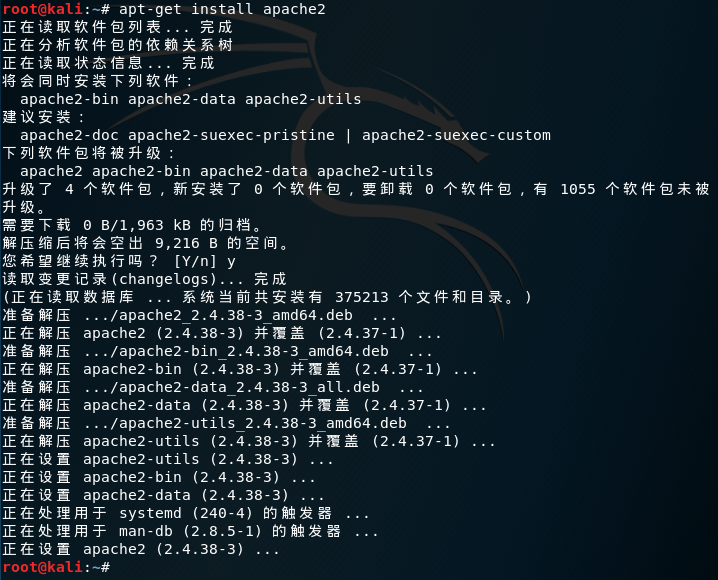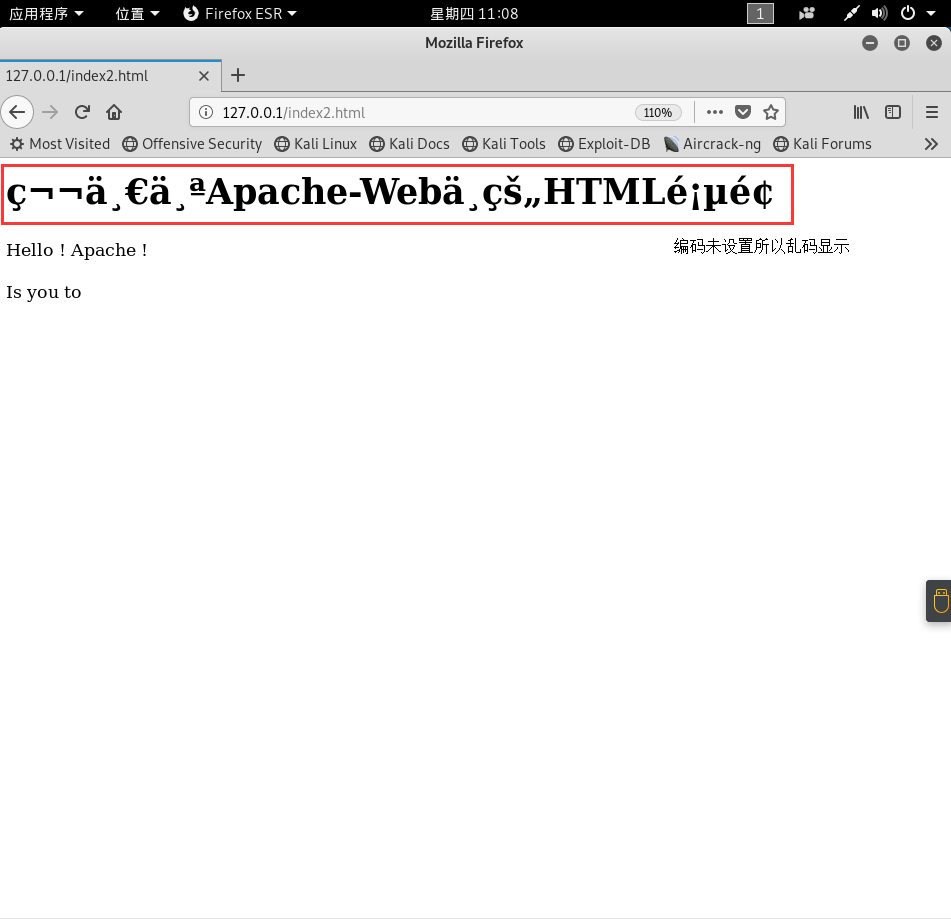Apache2 在Linux环境下的安装
安装Apache2:
apt-get install apache2

启动Apache2服务:
service apache2 start
在终端运行启动后,打开浏览器URL访问 http://localhost/ 或 127.0.0.1
显示的网页就是Apache2 Web Server 默认页[It works],由此可以断定Apache2 Web服务器正在运行

Apache的默认网页位于:/var/www/html/index.html ;可以通过编辑index.html文件提供想要的任何信息,可以通过更改文件代码改变html页面的显示方式和内容
<!DOCTYPE html PUBLIC "-//W3C//DTD XHTML 1.0 Transitional//EN" "http://www.w3.org/TR/xhtml1/DTD/xhtml1-transitional.dtd">
<html xmlns="http://www.w3.org/1999/xhtml">
<head>
<meta http-equiv="Content-Type" content="text/html; charset=UTF-8" />
<title>Apache2 Debian Default Page: It works</title>
<style type="text/css" media="screen">
* {
margin: 0px 0px 0px 0px;
padding: 0px 0px 0px 0px;
} body, html {
padding: 3px 3px 3px 3px; background-color: #D8DBE2; font-family: Verdana, sans-serif;
font-size: 11pt;
text-align: center;
} div.main_page {
position: relative;
display: table; width: 800px; margin-bottom: 3px;
margin-left: auto;
margin-right: auto;
padding: 0px 0px 0px 0px; border-width: 2px;
border-color: #212738;
border-style: solid; background-color: #FFFFFF; text-align: center;
} div.page_header {
height: 99px;
width: 100%; background-color: #F5F6F7;
} div.page_header span {
margin: 15px 0px 0px 50px; font-size: 180%;
font-weight: bold;
} div.page_header img {
margin: 3px 0px 0px 40px; border: 0px 0px 0px;
} div.table_of_contents {
clear: left; min-width: 200px; margin: 3px 3px 3px 3px; background-color: #FFFFFF; text-align: left;
} div.table_of_contents_item {
clear: left; width: 100%; margin: 4px 0px 0px 0px; background-color: #FFFFFF; color: #000000;
text-align: left;
} div.table_of_contents_item a {
margin: 6px 0px 0px 6px;
} div.content_section {
margin: 3px 3px 3px 3px; background-color: #FFFFFF; text-align: left;
} div.content_section_text {
padding: 4px 8px 4px 8px; color: #000000;
font-size: 100%;
} div.content_section_text pre {
margin: 8px 0px 8px 0px;
padding: 8px 8px 8px 8px; border-width: 1px;
border-style: dotted;
border-color: #000000; background-color: #F5F6F7; font-style: italic;
} div.content_section_text p {
margin-bottom: 6px;
} div.content_section_text ul, div.content_section_text li {
padding: 4px 8px 4px 16px;
} div.section_header {
padding: 3px 6px 3px 6px; background-color: #8E9CB2; color: #FFFFFF;
font-weight: bold;
font-size: 112%;
text-align: center;
} div.section_header_red {
background-color: #CD214F;
} div.section_header_grey {
background-color: #9F9386;
} .floating_element {
position: relative;
float: left;
} div.table_of_contents_item a,
div.content_section_text a {
text-decoration: none;
font-weight: bold;
} div.table_of_contents_item a:link,
div.table_of_contents_item a:visited,
div.table_of_contents_item a:active {
color: #000000;
} div.table_of_contents_item a:hover {
background-color: #000000; color: #FFFFFF;
} div.content_section_text a:link,
div.content_section_text a:visited,
div.content_section_text a:active {
background-color: #DCDFE6; color: #000000;
} div.content_section_text a:hover {
background-color: #000000; color: #DCDFE6;
} div.validator {
}
</style>
</head>
<body>
<div class="main_page">
<div class="page_header floating_element">
<img src="/icons/openlogo-75.png" alt="Debian Logo" class="floating_element"/>
<span class="floating_element">
Apache2 Debian Default Page
</span>
</div>
<!-- <div class="table_of_contents floating_element">
<div class="section_header section_header_grey">
TABLE OF CONTENTS
</div>
<div class="table_of_contents_item floating_element">
<a href="#about">About</a>
</div>
<div class="table_of_contents_item floating_element">
<a href="#changes">Changes</a>
</div>
<div class="table_of_contents_item floating_element">
<a href="#scope">Scope</a>
</div>
<div class="table_of_contents_item floating_element">
<a href="#files">Config files</a>
</div>
</div>
-->
<div class="content_section floating_element"> <div class="section_header section_header_red">
<div id="about"></div>
It works!
</div>
<div class="content_section_text">
<p>
This is the default welcome page used to test the correct
operation of the Apache2 server after installation on Debian systems.
If you can read this page, it means that the Apache HTTP server installed at
this site is working properly. You should <b>replace this file</b> (located at
<tt>/var/www/html/index.html</tt>) before continuing to operate your HTTP server.
</p> <p>
If you are a normal user of this web site and don't know what this page is
about, this probably means that the site is currently unavailable due to
maintenance.
If the problem persists, please contact the site's administrator.
</p> </div>
<div class="section_header">
<div id="changes"></div>
Configuration Overview
</div>
<div class="content_section_text">
<p>
Debian's Apache2 default configuration is different from the
upstream default configuration, and split into several files optimized for
interaction with Debian tools. The configuration system is
<b>fully documented in
/usr/share/doc/apache2/README.Debian.gz</b>. Refer to this for the full
documentation. Documentation for the web server itself can be
found by accessing the <a href="/manual">manual</a> if the <tt>apache2-doc</tt>
package was installed on this server. </p>
<p>
The configuration layout for an Apache2 web server installation on Debian systems is as follows:
</p>
<pre>
/etc/apache2/
|-- apache2.conf
| `-- ports.conf
|-- mods-enabled
| |-- *.load
| `-- *.conf
|-- conf-enabled
| `-- *.conf
|-- sites-enabled
| `-- *.conf
</pre>
<ul>
<li>
<tt>apache2.conf</tt> is the main configuration
file. It puts the pieces together by including all remaining configuration
files when starting up the web server.
</li> <li>
<tt>ports.conf</tt> is always included from the
main configuration file. It is used to determine the listening ports for
incoming connections, and this file can be customized anytime.
</li> <li>
Configuration files in the <tt>mods-enabled/</tt>,
<tt>conf-enabled/</tt> and <tt>sites-enabled/</tt> directories contain
particular configuration snippets which manage modules, global configuration
fragments, or virtual host configurations, respectively.
</li> <li>
They are activated by symlinking available
configuration files from their respective
*-available/ counterparts. These should be managed
by using our helpers
<tt>
a2enmod,
a2dismod,
</tt>
<tt>
a2ensite,
a2dissite,
</tt>
and
<tt>
a2enconf,
a2disconf
</tt>. See their respective man pages for detailed information.
</li> <li>
The binary is called apache2. Due to the use of
environment variables, in the default configuration, apache2 needs to be
started/stopped with <tt>/etc/init.d/apache2</tt> or <tt>apache2ctl</tt>.
<b>Calling <tt>/usr/bin/apache2</tt> directly will not work</b> with the
default configuration.
</li>
</ul>
</div> <div class="section_header">
<div id="docroot"></div>
Document Roots
</div> <div class="content_section_text">
<p>
By default, Debian does not allow access through the web browser to
<em>any</em> file apart of those located in <tt>/var/www</tt>,
<a href="http://httpd.apache.org/docs/2.4/mod/mod_userdir.html" rel="nofollow">public_html</a>
directories (when enabled) and <tt>/usr/share</tt> (for web
applications). If your site is using a web document root
located elsewhere (such as in <tt>/srv</tt>) you may need to whitelist your
document root directory in <tt>/etc/apache2/apache2.conf</tt>.
</p>
<p>
The default Debian document root is <tt>/var/www/html</tt>. You
can make your own virtual hosts under /var/www. This is different
to previous releases which provides better security out of the box.
</p>
</div> <div class="section_header">
<div id="bugs"></div>
Reporting Problems
</div>
<div class="content_section_text">
<p>
Please use the <tt>reportbug</tt> tool to report bugs in the
Apache2 package with Debian. However, check <a
href="http://bugs.debian.org/cgi-bin/pkgreport.cgi?ordering=normal;archive=0;src=apache2;repeatmerged=0"
rel="nofollow">existing bug reports</a> before reporting a new bug.
</p>
<p>
Please report bugs specific to modules (such as PHP and others)
to respective packages, not to the web server itself.
</p>
</div> </div>
</div>
<div class="validator">
</div>
</body>
</html>
index.html 默认内容
若是想让浏览器浏览我们想要的HTML内容,可以在该目录下添加新的HTML文件【添加新的HTML网页】:
<! index2.html >
<html>
<body>
<h1> 第一个Apache-Web中的HTML页面 </h1> <p> Hello ! Apache ! </p> <p> Is you to </p>
</body>
</html>
然后打开浏览器,访问 http://localhost/ 或 127.0.0.1 并没有看见自己的网站,依旧是apache默认的网页,这是因为index.html是默认第一加载的页面,此时的真实完整的URL是: http://localhost/index.html ;若想访问自己添加的页面,则需要改变URL:http://localhost/index2.html

`
——————
至此,Apache的简单安装运行介绍完毕!
如果需要关闭服务:service apache2 stop
如果需要重启服务:serivce apache2 restart
Apache2 在Linux环境下的安装的更多相关文章
- 全世界最详细的图形化VMware中linux环境下oracle安装(二)【weber出品必属精品】
<ORACLE 10.2.05版本的升级补丁安装> 首先我们解压 $ unzip p8202632_10205_LINUX.zip 解压后我们会发现多出了个文件夹,他是:Disk1,进入D ...
- 全世界最详细的图形化VMware中linux环境下oracle安装(一)【weber出品必属精品】
安装流程:前期准备工作--->安装ORACLE软件--->安装升级补丁--->安装odbc创建数据库--->安装监听器--->安装EM <前期准备工作> 安装 ...
- Linux 环境下 Lua 安装(转)
系统环境:CentOS-6.2-x86_64. Lua 是嵌入式脚本语言,应用场景很广泛. 引自官网:Lua is used in many products and projects around ...
- 基础--Redis在Linux环境下的安装
1. 安装redis服务 1.1 检查安装依赖程序 yum install gcc-c++yum install -y tclyum install wget 1.1.1 下载redis安装包 (或者 ...
- LINUX环境下SVN安装与配置(利用钩子同步开发环境与测试环境)
安装采用YUM一键安装: 1.环境Centos 6.6 2.安装svnyum -y install subversion 3.配置 建立版本库目录mkdir /www/svndata svnserve ...
- Linux环境下mysql安装并配置远程访问
环境:centOS 1.下载mysql安装文件 [root@localhost ~]# wget http://dev.mysql.com/get/mysql-community-release-el ...
- linux环境下redis安装
本篇文章主要说明的是Linux环境下redis数据库的安装: 首先进入目标目录: 下载安装包,执行命令: wget http://download.redis.io/releases/redis-4. ...
- Linux环境下Oracle安装参数设置
前面讲了虚拟机的设置和OracleLinux的安装,接下来我们来说下Oracle安装前的准备工作.1.系统信息查看系统信息查看首先服务器ip:192.168.8.120服务器系统:Oracle Lin ...
- Redis在linux环境下的安装
下载Redis安装包 wget http://download.redis.io/releases/redis-3.2.9.tar.gz 解压Redis安装包 tar -zxvf redis-3.2. ...
随机推荐
- 使用Redis实现延时任务(二)
前提 前一篇文章通过Redis的有序集合Sorted Set和调度框架Quartz实例一版简单的延时任务,但是有两个相对重要的问题没有解决: 分片. 监控. 这篇文章的内容就是要完善这两个方面的功能. ...
- Flask 教程 第九章:分页
本文翻译自The Flask Mega-Tutorial Part IX: Pagination 这是Flask Mega-Tutorial系列的第九部分,我将告诉你如何对数据列表进行分页. 在第八章 ...
- javaWeb综合案例
商城案例 分模块:用户模块→ 分类模块 → 商品模块→购物车模块(最难)→ 订单模块 后台模块(往前台的数据的增删改查) 今日任务: 1用户注册 a注册完成 b给注册人发邮件 2用户激活 a 去邮箱激 ...
- PHP http_response_code 网络函数
定义和用法 http_response_code - 获取/设置响应的 HTTP 状态码 版本支持 PHP4 PHP5 PHP7 不支持 支持 支持 语法 http_response_code ([ ...
- 三大免费开源的php语言cms系统 用好它们让你一天建好一个网站
php语言只所以在web开发领域占据半壁江山,是因为它有太多的生态,成熟的框架体系,广泛的开源cms系统.建设网站的时候,都想提升开发效率,效率就是成本,如果你用原生php语言开发一个项目,既要设计数 ...
- 手把手教你避开组件cover-view的那些坑
腾讯位置服务基于微信提供的小程序插件能力,专注于(围绕)地图功能,打造一系列小程序插件,可以帮助开发者简单.快速的构建小程序,是您实现地图功能的最佳伙伴.目前微信小程序插件提供路线规划.地铁图.地图选 ...
- HTML Rendering Error
刚下载的markdown弹窗提示html渲染错误 去官网 http://markdownpad.com/faq.html#livepreview-directx 页面搜索 This view h ...
- JUC-9-线程按序交替
package com.wf.zhang.juc; import java.util.concurrent.locks.Condition; import java.util.concurrent.l ...
- Spring Cloud中五大神兽总结(Eureka/Ribbon/Feign/Hystrix/zuul)
Spring Cloud中五大神兽总结(Eureka/Ribbon/Feign/Hystrix/zuul) 1.Eureka Eureka是Netflix的一个子模块,也是核心模块之一.Eureka是 ...
- acwing 873. 欧拉函数 模板
地址 https://www.acwing.com/problem/content/875/ 给定n个正整数ai,请你求出每个数的欧拉函数. 欧拉函数的定义 输入格式 第一行包含整数n. 接下来n行, ...
